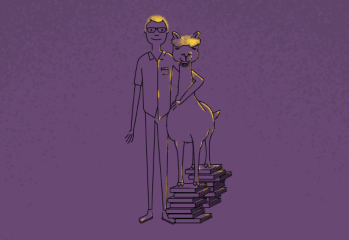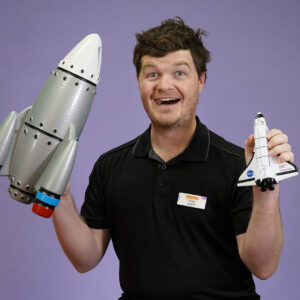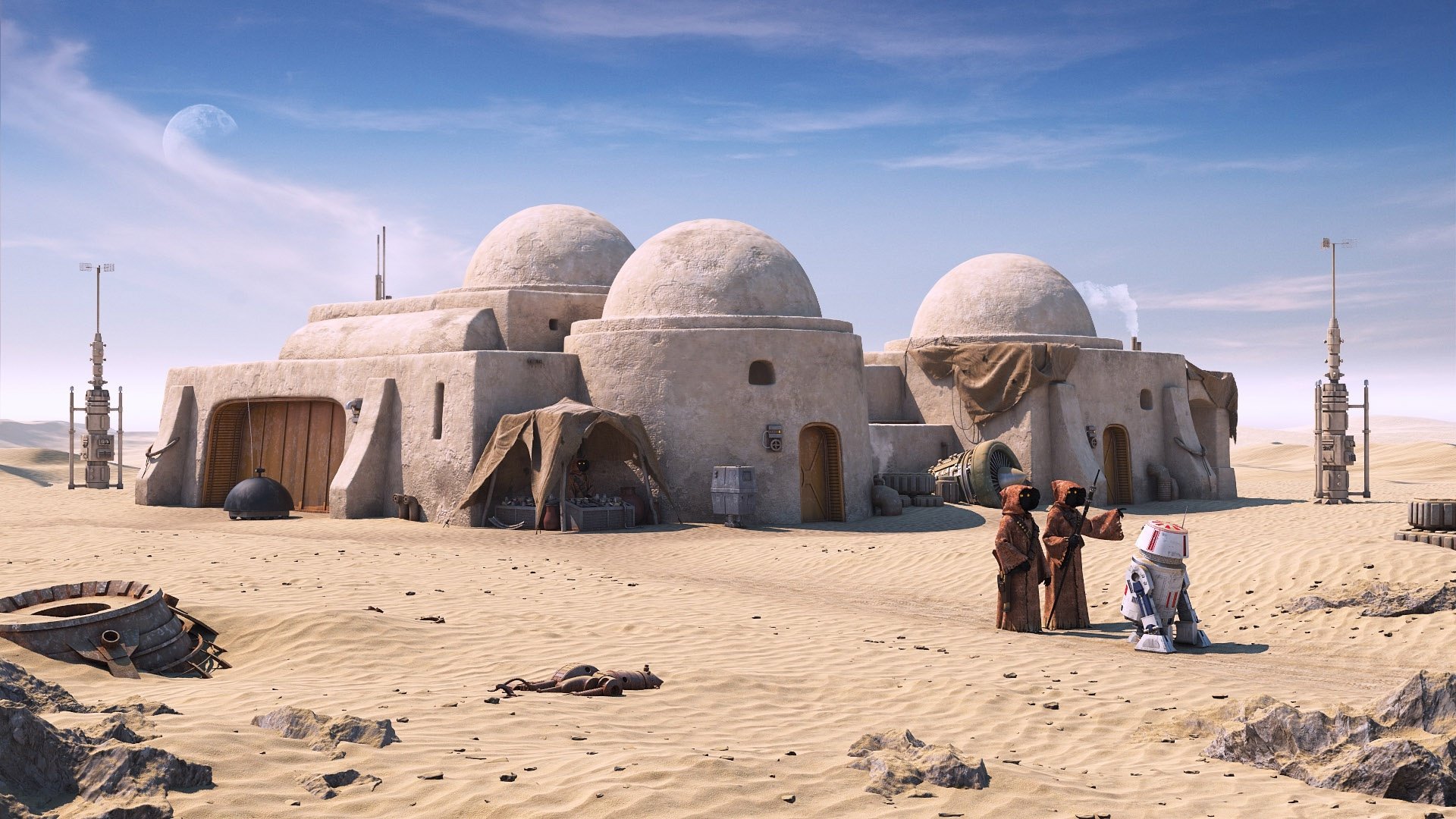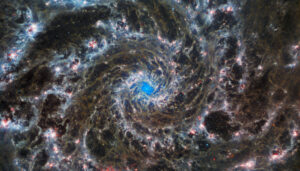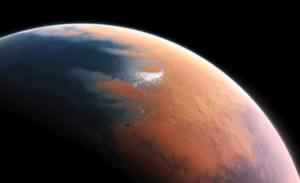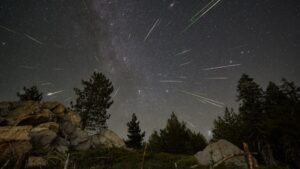The planet Tatooine in the Star Wars saga famously has two suns.
Despite sounding like something that would only appear in science fiction, astronomers had previously discovered 16 planets in a two-star system just like Tatooine.
In April 2025, astronomers from the UK and France presented evidence for the 17th example. But this one has a twist, literally.
Rather than orbiting the stars in the same plane, like peas all rolling around on a plate, this proposed planet jumps up out of the plate and moves at a right angle to the orbit of the stars.
Theoretical models suggest this was possible under the right circumstances, and now it just might be confirmed.
Image: Artistic representation of the planet orbit (orange) tipped sideways to the orbit of its stars (blue).
Credit: ESO
STAR WARS PREDICTS THE FUTURE
Scientists had previously found disks of material in strange orbits like this, so from a certain point of view it was only a matter of time before a planet in this inclination was discovered.
Things do get more unusual though. The ‘stars’ in this system, excitingly named 2M1510(AB), are not technically stars in the usual sense.
They are brown dwarfs —objects that are much, much heavier than even the biggest planets, but still not quite big enough to be main sequence stars. They exist in a strange no-man’s-sky between the two concepts.
Image: Artist impression of a brown dwarf. Not quite a star, not quite a planet.
Credit: NASA
For a movie made when we hadn’t found any planets around other stars, we have to give a nod to the surprisingly prescient foresight of Star Wars.
GOOGLE MAPS WON’T HELP HERE
On the contrary, despite C3P0’s urgent insistence, the possibility of successfully navigating an asteroid field is significantly better than 3720 to 1.
For the asteroid belt in our Solar System – a collection of millions of rocky objects between Mars and Jupiter – individual asteroids are so far apart that you may die of boredom flying a spaceship through there.
You have to deliberately go out of your way to get a close look at one of them, which is exactly what NASA’s Lucy spacecraft did on April 21, flying close by the asteroid named “Donaldjohanson”.
Image: Asteroid Donaldjohanson up close. At about 8km long, the asteroid is larger than the camera’s field of view.
Credit: NASA/Goddard/SwRI/Johns Hopkins APL/NOIRLab
Lucy is on a mission to study 8 different asteroids. While asteroid Donaldjohanson was not a primary science target for the mission, this flyby served as an excellent test of the spacecraft’s capabilities.
LUCY THE FOSSIL, SPACESHIP AND SONG
The Lucy spacecraft is named after the Lucy fossil, a 3.6-million-year-old early humanoid. She was from a family of common ancestry to modern humans known to walk upright on two feet.
The fossil was discovered in Ethiopia by palaeontologist Donald Johanson in 1974 and was itself named for the song ‘Lucy in the Sky with Diamonds’.
Interestingly, this is the second asteroid that Lucy has visited, the first one being asteroid Dinkinesh in 2023. Dinkinesh is the Ethiopian phrase for “you are marvellous” and was Johanson’s preferred name for the fossil.
Image: The Lucy fossil on display.
Credit: Public Domain
AMBITION? I DON’T KNOW HER
The Lucy spacecraft is a hugely ambitious mission.
In the same way that the Lucy fossil reveals our past, the Lucy spacecraft could reveal secrets to the origin of our Solar System, our planet, and us.
Scientists think that planets in our Solar System formed by a process called accretion. Basically, from little things big things grow.
Pieces of dust stick together to make pebbles, pebbles stick together to make rocks, rocks stick together to make bigger rocks and so on until they are planets.
The asteroids in our solar system are leftover remnants of this process from more than 4.5 billion years ago when the planets were taking shape.
But planets and asteroids have changed a lot since they were new.
On Earth we have weather and geology that long ago buried and blew away any clues to how our planet formed.
Asteroids themselves frequently collide with each other, losing their original information.
Except for a few near Jupiter.
Image: The Trojan and Greek asteroids (green) near Jupiter are time capsules to the history of the Solar System.
Credit: Public Domain
SECRET KEEPERS
Jupiter’s enormous size has allowed it to ‘bully’ the asteroid belt. Along the way it captured a few asteroids – the Trojans and Greeks, collectively called “the Trojans” – knocking them into a special orbit called a Lagrange point.
These asteroids share Jupiter’s orbit away from the main belt.
Because of the way gravity works, asteroids in these Lagrange points are stuck there forever.
They can’t escape or interact with the rest of the Solar System, and they have been stuck ever since Jupiter first formed more than 4.5 billion years ago.
This means they are older than Earth.
They are time capsules to the beginnings of our Solar System. They contain answers to what the Solar System looked like when it was forming, how minerals were distributed, and maybe even the molecules that later formed life on Earth.
Visiting them to find out what they are made of and how they behave will give us clues to how life formed on our planet and how Earth got to be the way that it is today.
Where the Lucy fossil lit the candle on humankind’s past, the Lucy spacecraft will do the same on a much grander scale.
The spacecraft will visit six Trojan asteroids over the next eight years.
Interestingly, asteroid Donaldjohanson is not a Trojan asteroid, but it was close enough to Lucy’s flight path for it to take a look, so it did.
Image: Lucy’s flight path will take it to visit six Trojan asteroids by 2033.
Credit: Public Domain
SO FAR APART
Over this twelve-year journey, Lucy will cross the main asteroid belt several times as well as pass through both clusters of Trojan asteroids.
Yet, it will only get close enough to 8 asteroids to study in detail.
Asteroids are really, really far apart. Rather than needing the Millenium Falcon to dodge them, you need Lucy to actually get close to them.
Lucy’s next asteroid encounter – the first Trojan asteroid it meets – will be asteroid Eurybates on August 12, 2027.
Until then, scientists will be keenly studying the information Lucy collected about Donaldjohanson to confirm that the spacecraft is working properly.
Does anybody else have Lucy in the Sky with Diamonds going through their head right now?
